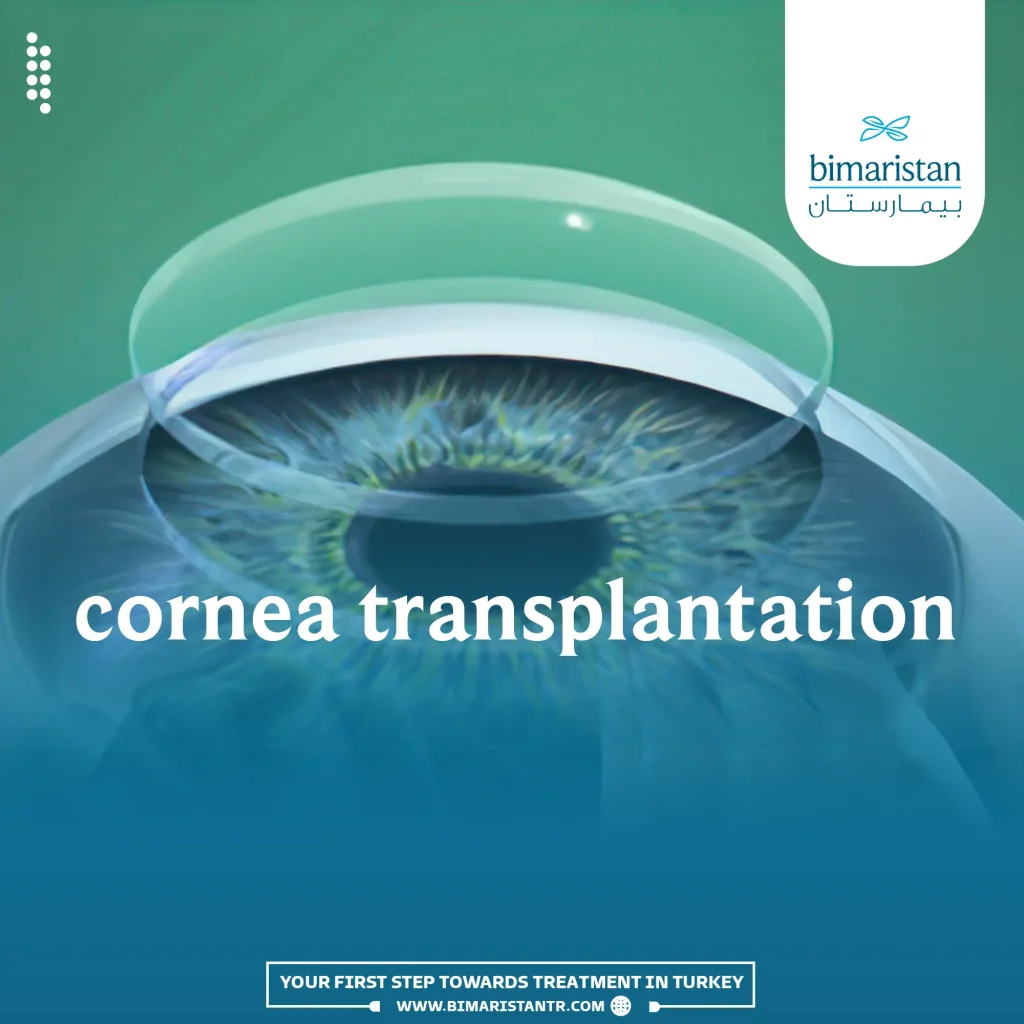Corneal transplantation is a surgery that replaces a damaged cornea with a new one to improve vision and enhance the appearance of the eye.
It has become a common surgical procedure in 2024, with a very low failure rate due to significant advancements in the medical field, especially in Turkey.
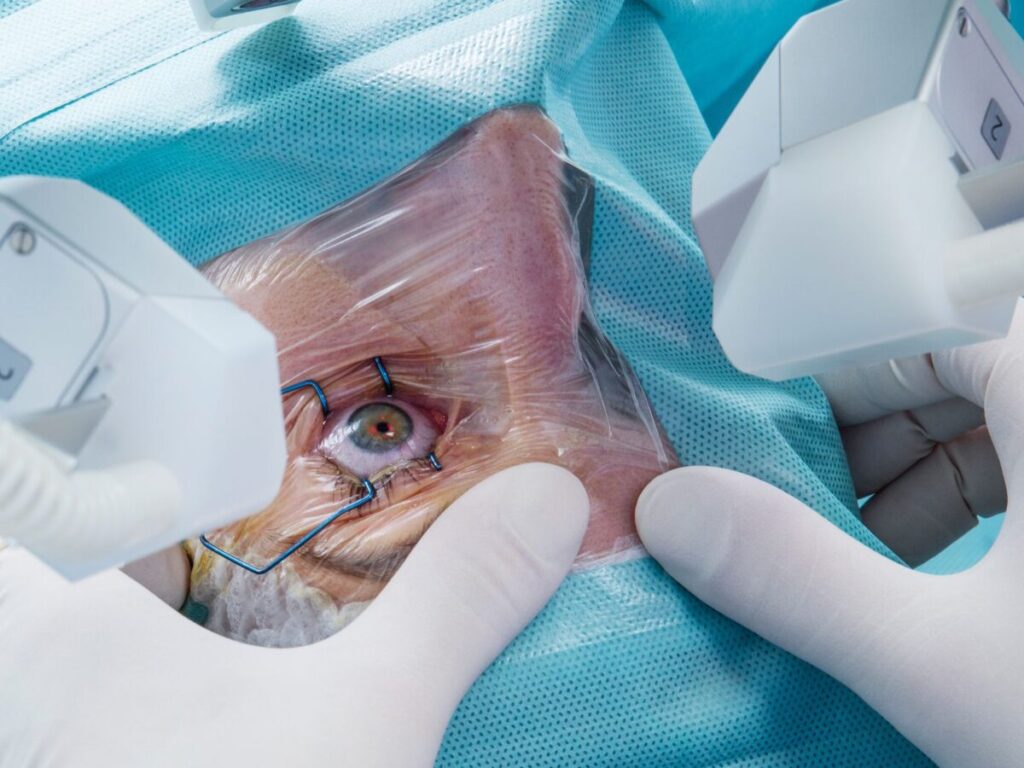
The procedure can significantly improve vision, enhance the appearance of the damaged cornea, and reduce pain and discomfort associated with the condition. It is considered the ultimate treatment for all corneal problems and diseases.
What is corneal transplantation?
The cornea is the transparent layer at the front of the eye that helps focus light for clear vision. When it is damaged, it may need to be replaced. The new cornea is obtained from individuals who have chosen to donate their corneas after their death ”cornea donors”.
Corneal transplantation, also known as corneal grafting, involves removing all or part of the patient’s cornea and replacing it with a healthy cornea from a donor.
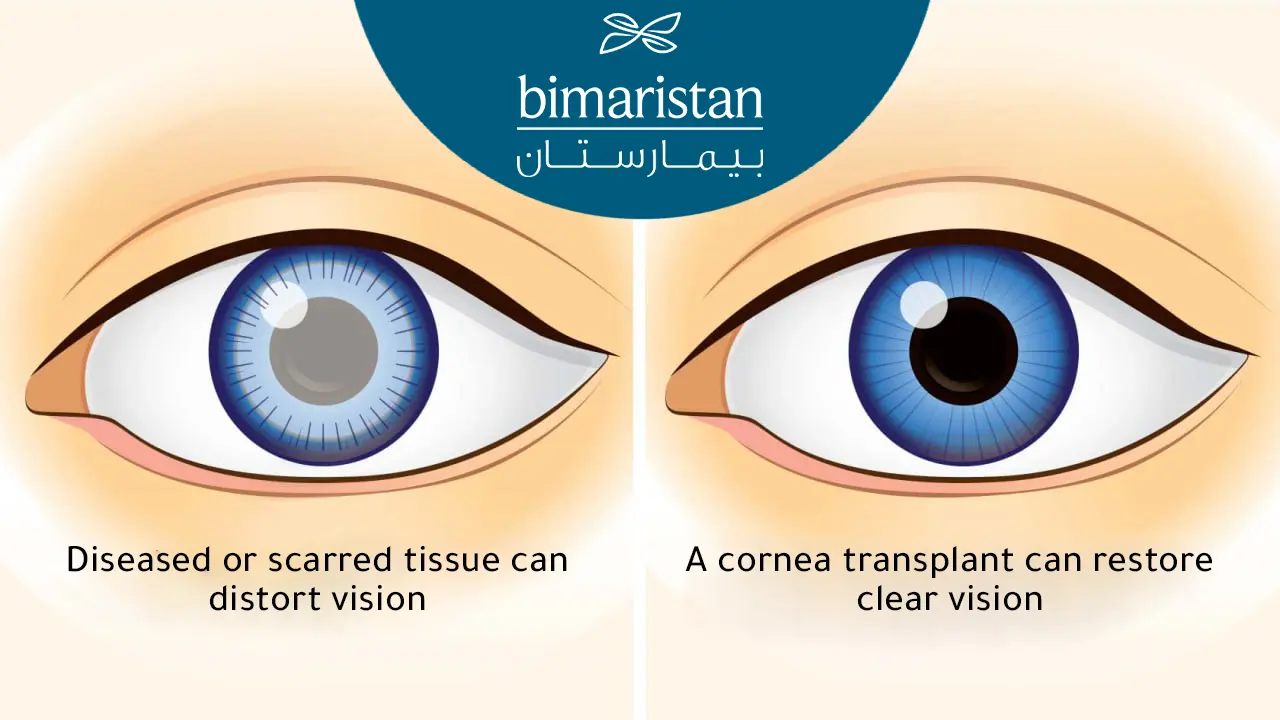
It is important to note that there is no correlation between tissue matching of donor and recipient tissues and the rejection rate after transplantation. However, most cases of rejection can be managed through medication.
The difference between corneal transplantation and lens transplantation
Corneal transplantation involves replacing the layer at the front of the eye, allowing light to pass through and focus on the retina. On the other hand, lens transplantation involves replacing the transparent disc behind the cornea and iris, allowing light to pass through to the retina in its natural state.
Who needs corneal transplantation?
There are several reasons and diseases that affect the cornea and significantly impact its function, sometimes necessitating corneal transplantation. The most common reasons for corneal transplantation are:
- keratoconus (corneal bulging)
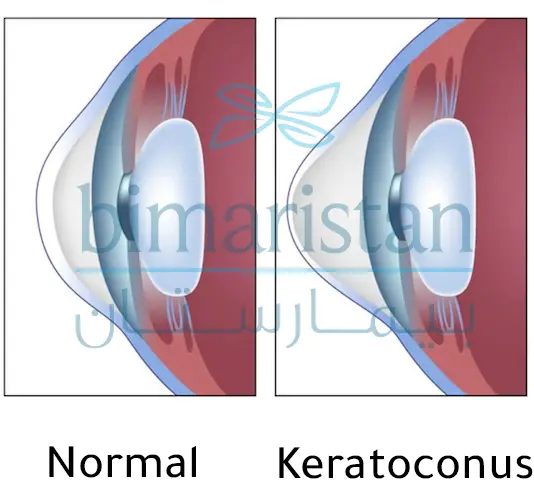
- genetic eye diseases such as Fuchs’ dystrophy
- Corneal ulceration or sepsis that does not respond to antibiotics.
- corneal scarring due to injury or infection
- corneal thinning or tearing
- complications from previous eye surgery
As for cataract disease, it affects the lens of the eye and requires an eye lens transplant.
Preparation for corneal transplantation
Several tests need to be conducted before corneal transplantation, such as comprehensive eye examinations to detect other existing diseases that may cause problems during or after the procedure. A complete blood analysis is also necessary to detect any blood disorders.
You may need to stop taking certain medications before surgery, especially blood-thinning medications. Therefore, you should inform your doctor of all medications you are taking.
You will typically need to use antibiotic eye drops the day before the transplant surgery to help prevent infection.
Surgical transplant of the cornea in Turkey
There are several surgical techniques used for corneal transplantation in Turkey, selected based on the degree of corneal damage. These techniques include:
Full-thickness corneal transplantation
In this technique, the damaged cornea’s front and back layers are removed and replaced with a healthy cornea from a donor. This is done with a circular cutting instrument called a trephine, which is widely used in corneal surgery.
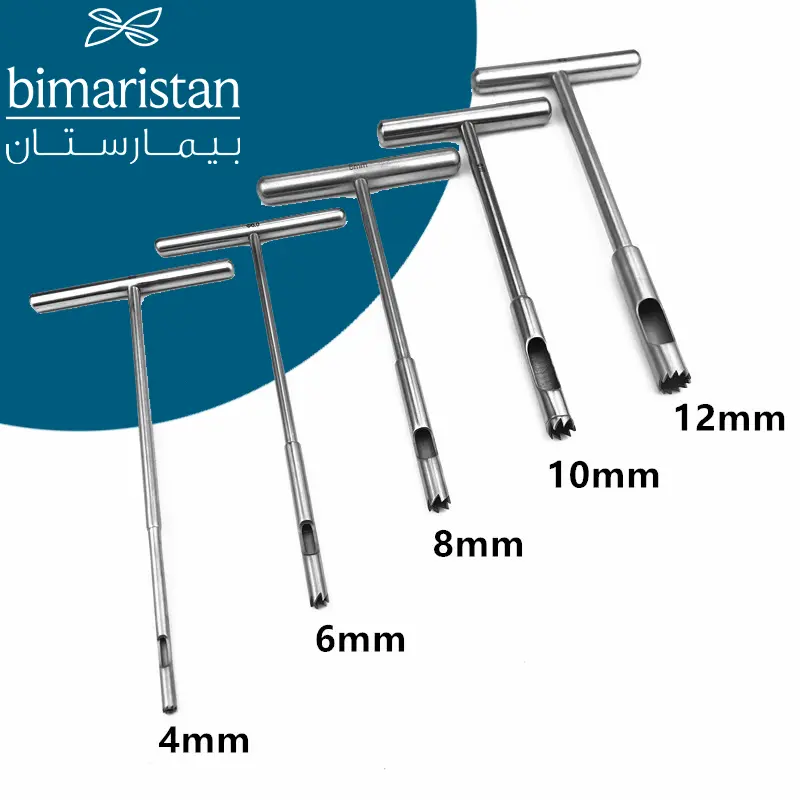
This procedure, known as penetrating keratoplasty (PK), involves stitching the new cornea onto your eye with very fine sutures. You may need this procedure if you have severe corneal injury, bulging, or scarring.
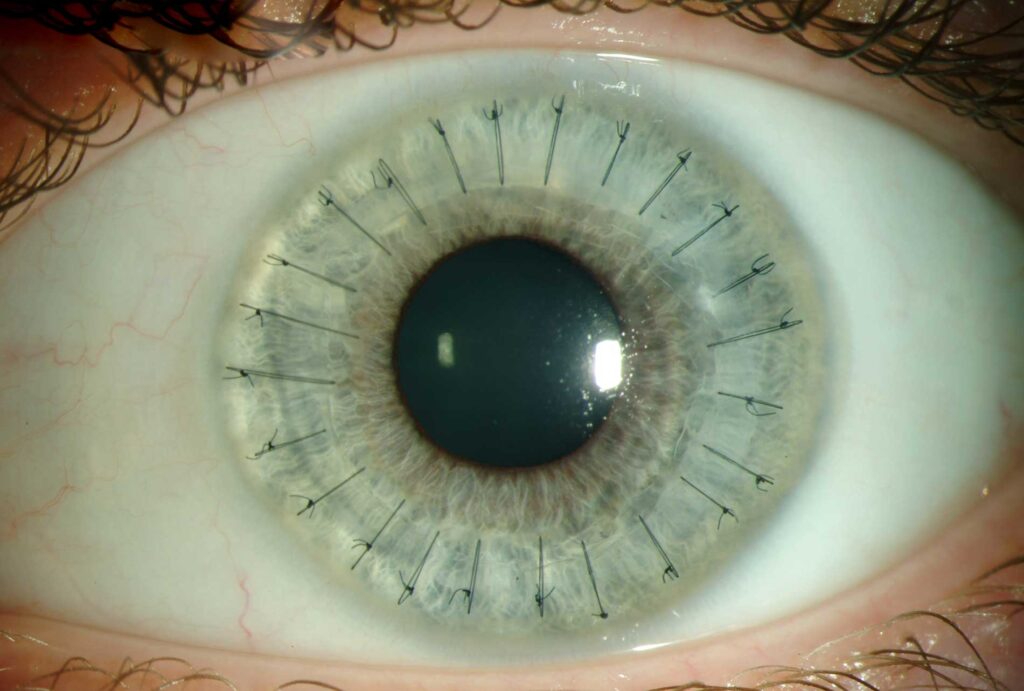
The duration of a corneal transplantation surgery is usually around one to two hours, often performed under local anesthesia or occasionally under general anesthesia.
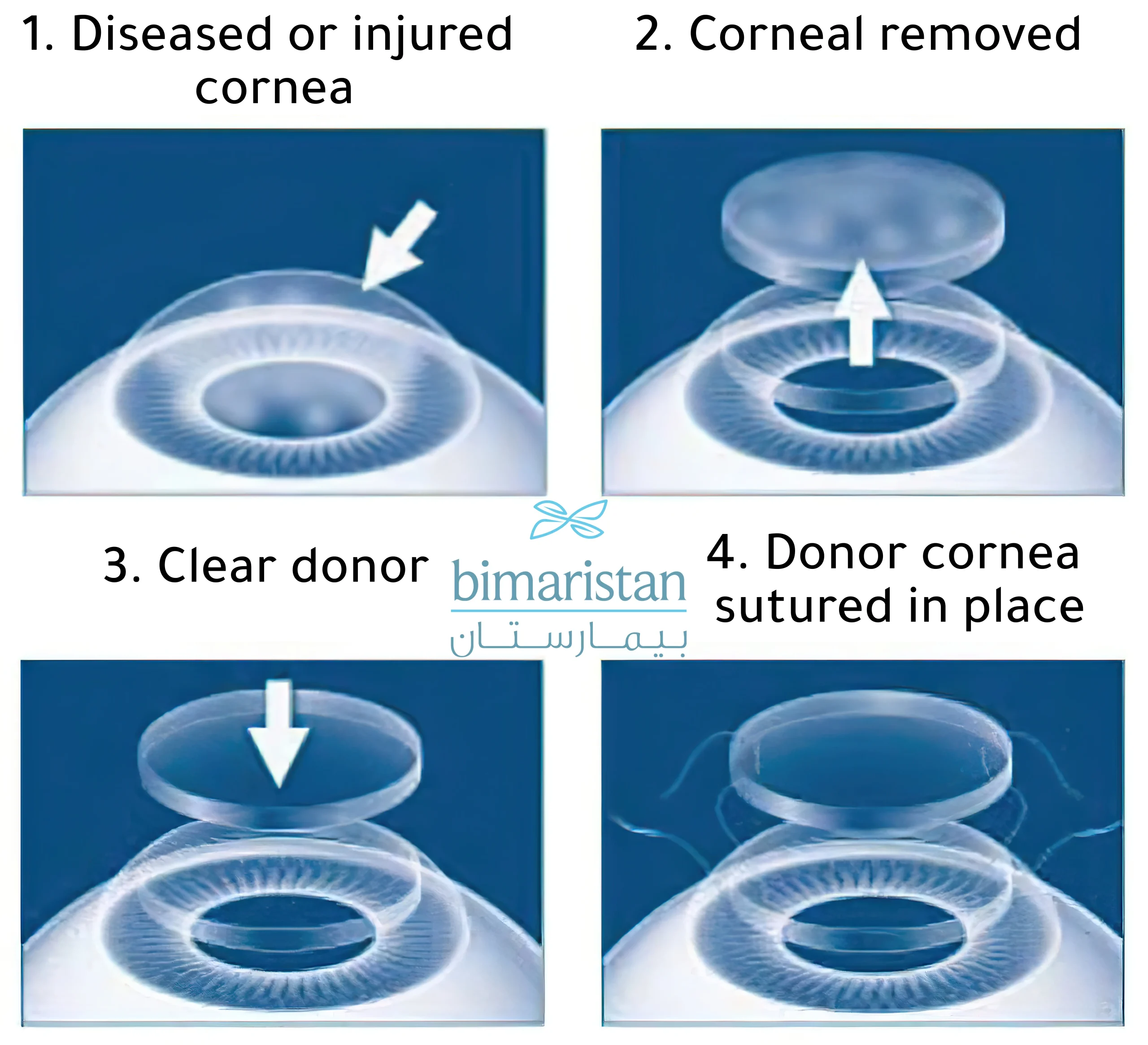
The disadvantages of this technique include:
- It requires a longer recovery period compared to other techniques, and full vision restoration may take about a year or more.
- It carries a higher risk of immune rejection of the transplanted cornea.
- The patient may sometimes need to stay overnight in the hospital for the procedure.
Partial Thickness Corneal Transplantation
This procedure may be performed for individuals with conditions such as keratoconus or corneal scarring that have not affected the inner layers. In this procedure, one of the front layers of the damaged cornea is removed while the back layer is left intact and healthy.
During the deep anterior lamellar keratoplasty, the surgeon injects air to lift and separate the middle and superficial front layers, then removes them and replaces them with a new cornea.
Surgical techniques used in cases where damage is limited to the front part of the cornea include:
- Anterior Lamellar Keratoplasty (ALK): The outer front layers of the cornea are removed and replaced.
- Deep Anterior Lamellar Keratoplasty (DALK): The front and middle layers of the cornea are removed and replaced.
Like in penetrating keratoplasty, several sutures are used to secure the corneal tissues for both of these procedures.
The advantages of these techniques include:
- A shorter recovery period than the previous method allows the patient to return home on the same day.
- There is less risk of damaging the lens and iris since there is no need to open the eye itself.
- Reduced risk of infection inside the eye.
- Lower risk of immune rejection compared to the previous method.
Posterior Corneal Transplantation without Sutures
Also known as Endothelial Keratoplasty (EK), this procedure involves replacing only the cornea’s inner layer for individuals with problems in this area. Surgical techniques used in this procedure include:
Descemet stripping endothelial keratoplasty (DSEK or DSAEK)
It is the most common type of endothelial keratoplasty and is used for Fuchs’ dystrophy and other similar medical conditions.
We remove the endothelium (which is one thick layer of cells) and Descemet’s membrane (inner membrane) directly above it, as well as about 20% of the corneal supporting tissue (corneal parenchyma or corneal stroma).
Studies have shown that very good results have been obtained by performing this operation after the failure of a complete corneal transplant.
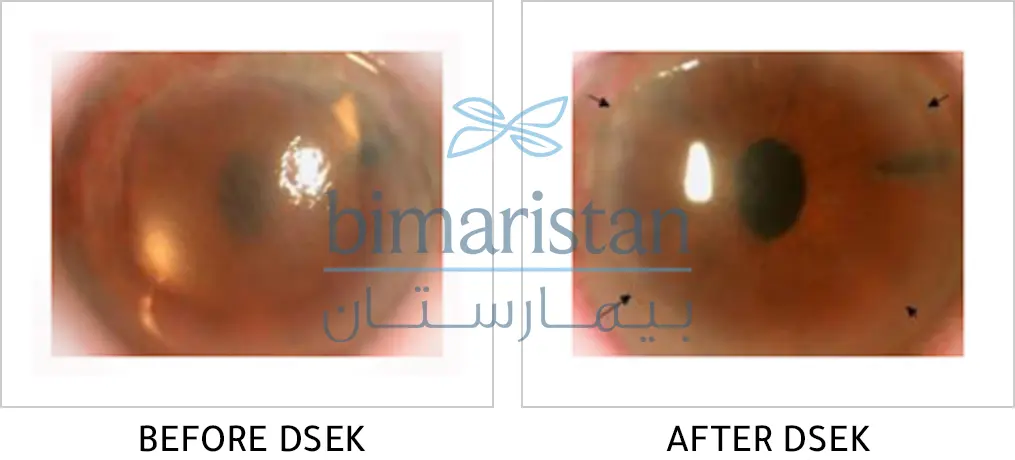
Descemet’s endothelial keratoplasty (DMEK)
It is the least invasive technique, as only the endothelium and Descemet’s membrane are replaced without any part of the corneal parenchyma.
The risk of complications after performing these techniques is very low, in addition to the faster recovery of patients.
One of the advantages of these techniques is that an air bubble is used temporarily to stabilize the cornea; Therefore, there is no need for surgical stitches to stabilize the transplanted corneal tissue.
When are each of these operations performed?
With DSEK/DSAEK surgery, donor tissue may be easier to transplant and place because it is thicker than the tissue required in DMEK surgery.
In DMEK surgery, the donor tissue is thin and can be more difficult to transplant. However, recovery is faster because the transplanted tissue is thinner.
Your eye surgeon will choose the type of surgery based on the condition of your cornea.
The third option for patients with Fuchs’ dystrophy is simple removal of the central portion of the inner membrane without transplantation. It is used to restore the removed area if the surrounding cornea looks good enough.

Corneal Transplantation successful rate
The success rate of full-thickness corneal transplantation is approximately 90%, while partial-thickness transplantation has a success rate of about 99%. These success rates may vary depending on the patient’s health condition and the surgeon’s experience.
After cornea transplant surgery
After the corneal transplantation, you may need to wear an eye shield for at least a day, possibly up to 4 days, while the outer layer of the cornea heals. Your eye may be red and sensitive to light, and there may be some pain for a few days, but some people may not experience any discomfort.
Your doctor will want to examine your eye on the day after surgery, several times over the following two weeks, and then several times over the first year.
For procedures such as DSEK and DMEK that use a gas bubble inside the eye to help position the transplanted tissues, the surgeon may require you to lie down at times during the day and sleep flat on your back at night for several days.
It may take several weeks to a year for your vision to fully improve, but your vision may worsen slightly before reaching the final result. You will need to protect your eye from injury after surgery. Follow your doctor’s instructions carefully.
You may need to adjust your glasses or contact lens prescription to include astigmatism correction because the transplanted tissues will not be perfectly round.
Your cornea does not receive any blood, so it heals slowly. If surgical stitches are required during the procedure, your doctor will remove them in the clinic after a few months.
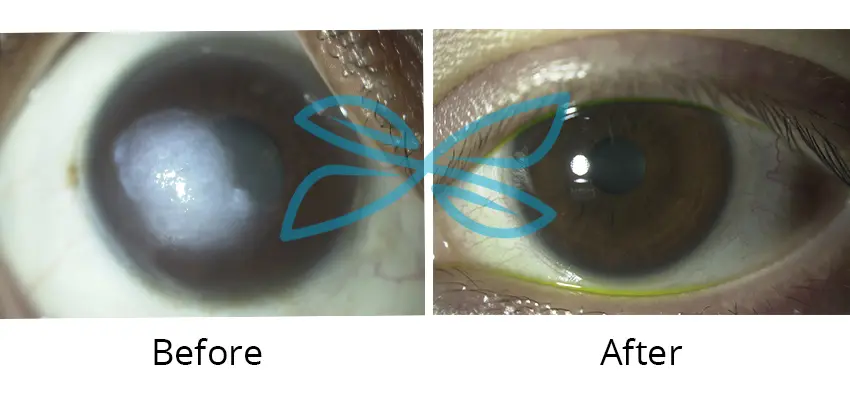
Tips after corneal transplantation
- Wear sunglasses to avoid light sensitivity after corneal transplantation.
- Wear an eye shield for protection while sleeping for a few weeks after corneal transplantation surgery.
- Adhere to daily eye drops containing steroids and antibiotics as they help reduce inflammation and swelling and play an important role in preventing corneal rejection.
Prohibitions after corneal transplantation
- Avoid rubbing your eye after corneal transplantation surgery.
- Avoid strenuous work that requires physical effort for a month or two after corneal transplantation surgery.
- Stay away from smoke and dust after the operation, as it can cause severe irritation to the transplanted cornea.
- Be careful not to let water enter your eye while bathing for a month after the operation.
- Do not drive until your specialist tells you it is safe.
Rejected corneal transplant
Corneal transplant rejection is a very common problem that occurs after a corneal transplant surgery. It is a condition in which the patient’s immune system recognizes the transplanted cornea as a foreign body and attacks it.
Some studies have shown that the rejection rate in a full-thickness corneal transplant is about 20%, while rejection in a partial corneal transplant is rare. Due to the small portion of donor tissue that is transplanted in stitchless corneal transplantation (DSEK and especially DMEK), the rejection rate is very small.
Rejection of the transplanted cornea usually occurs months after the operation, but in some cases, rejection may occur after only a few weeks.
Corneal transplant rejection symptoms
- Redness of the eye
- High light sensitivity
- Vision problems, especially blurry vision
- Severe eye pain
Cornea transplant rejection treatment
In certain cases of corneal transplant rejection, symptoms can be treated and controlled using steroid eye drops if treatment is started early.
Sometimes, we may need to repeat the corneal transplantation surgery due to rejection. It is worth noting that the rejection rate in the second operation is higher than in the first operation. Still, in cases of recurrent rejection, we may resort to implanting an artificial cornea for the patient (keratoprosthesis).
What are the disadvantages of corneal transplant?
As with most surgical procedures, corneal transplantation (especially penetrating keratoplasty) carries a high risk of many damages and complications after surgery, including:
- Astigmatism
- Glaucoma
- Iritis
- Retinal detachment
- Internal infection at the surgical site
- Bleeding due to surgical incisions
- Postoperative pain
- The possibility of the underlying disease that led to the need for corneal transplantation is recurring.
Cornea Transplant Cost in Turkey
With medical advancements worldwide, it has become possible to perform corneal transplantation with greater precision and safety, especially in Turkey, which is considered the best country for corneal transplantation. The corneal eye transplant cost in Istanbul starts at $5,000 USD, depending on the patient’s condition and the procedure used.
Bimaristan Medical Center remains your first choice for treatment in Turkey. We will guide you to Turkey’s best and most affordable corneal transplantation centers. We only work with the best experts specializing in all types of corneal transplantation. We break the language barrier through specialized Arab doctors who help you communicate with your doctor. We help you book appointments at the most important and latest hospitals in Turkey and accompany you step by step toward recovery.
In the end, corneal transplantation in Turkey is characterized by being performed under the supervision of specialized ophthalmologists, especially in corneal surgery, and by the modern medical equipment available in specialized Turkish centers.
Sources:
- Shroff Eye Mumbai
- Cambridge vision clinic
- Hornhautbank München
